Landscape and rodent community composition are associated with risk of hemorrhagic fever with renal syndrome in two cities in China, 2006-2013
- PMID: 29329512
- PMCID: PMC5767038
- DOI: 10.1186/s12879-017-2827-5
Landscape and rodent community composition are associated with risk of hemorrhagic fever with renal syndrome in two cities in China, 2006-2013
Abstract
Background: Hemorrhagic fever with renal syndrome (HFRS) is a rodent-borne disease caused by hantaviruses. Landscape can influence the risk of hantavirus infection for humans, mainly through its effect on rodent community composition and distribution. It is important to understand how landscapes influence population dynamics for different rodent species and the subsequent effect on HFRS risk.
Methods: To determine how rodent community composition influenced human hantavirus infection, we monitored rodent communities in the prefecture-level cities of Loudi and Shaoyang, China, from 2006 to 2013. Land use data were extracted from satellite images and rodent community diversity was analyzed in 45 trapping sites, in different environments. Potential contact matrices, determining how rodent community composition influence HFRS infection among different land use types, were estimated based on rodent community composition and environment type for geo-located HFRS cases.
Results: Apodemus agrarius and Rattus norvegicus were the predominant species in Loudi and Shaoyang, respectively. The major risk of HFRS infection was concentrated in areas with cultivated land and was associated with A. agrarius, R. norvegicus, and Rattus flavipectus. In urban areas in Shaoyang, Mus musculus was related to risk of hantavirus infection.
Conclusions: Landscape features and rodent community dynamics may affect the risk of human hantavirus infection. Results of this study may be useful for the development of HFRS prevention initiatives that are customized for regions with different geographical environments.
Keywords: Hantavirus infection; Hemorrhagic fever with renal syndrome; Landscape; Rodent community composition.
Conflict of interest statement
Ethics approval and consent to participate
The present study was reviewed and approved by the research institutional review board of the Hunan Provincial Centre for Disease Control and Prevention (CDC). In this study, all the patient medical data analyzed were anonymized for the consideration of confidentiality, only aggregated data were used in the data analysis and no personal information has been used. The whole rodent trapping campaign obtained new samples specifically for this study and was validated by the Animal Ethics Committee of the Hunan CDC. Because the methods did not include animal experimentation, it was not necessary to obtain an animal ethics license. Furthermore, none of the rodent species investigated in the present study are protected in China and none of the species captured are included in the China Species Red List.
Consent for publication
Not applicable.
Competing interests
We have read and understood BMC Infectious Diseases policy on declaration of interests and declare that we have no competing interests.
Publisher’s Note
Springer Nature remains neutral with regard to jurisdictional claims in published maps and institutional affiliations.
Figures
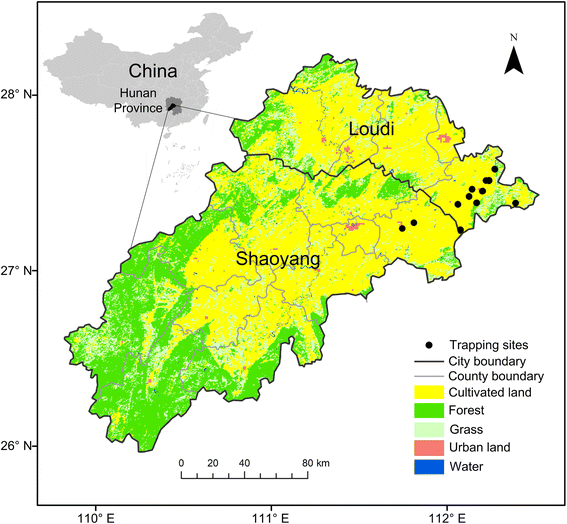
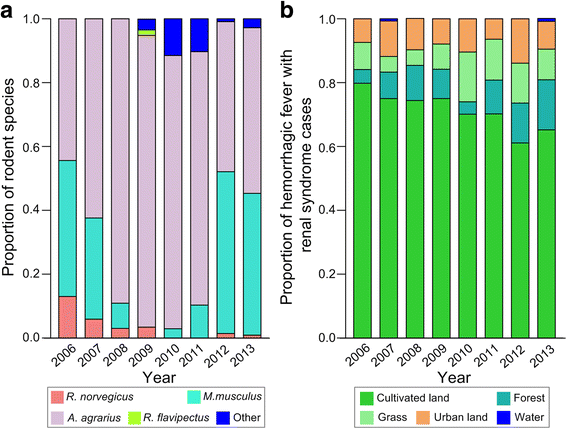

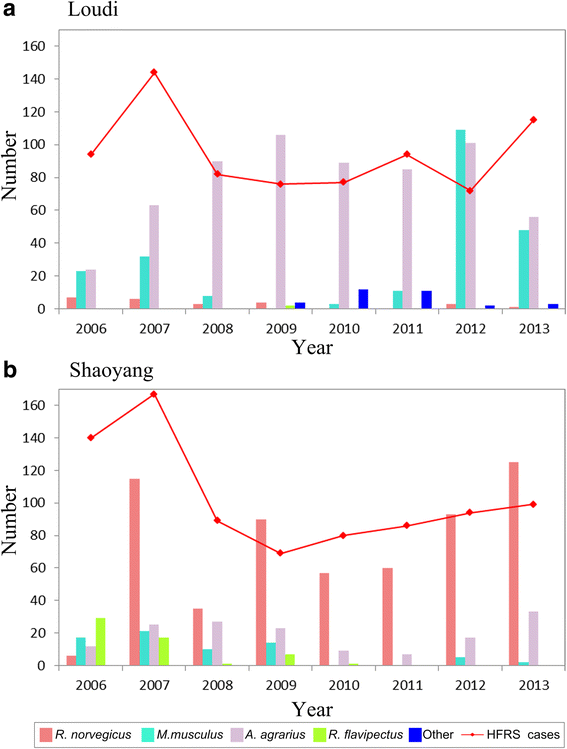
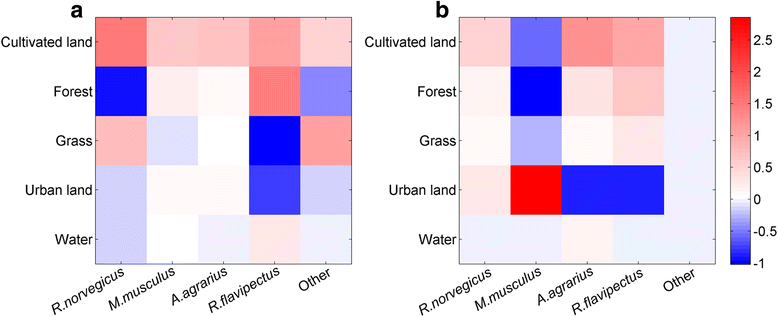

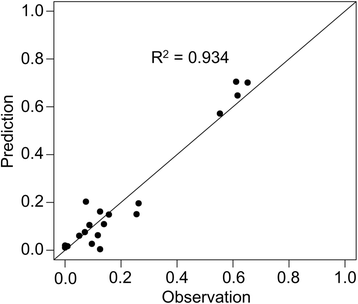
Similar articles
-
Spatial heterogeneity of hemorrhagic fever with renal syndrome is driven by environmental factors and rodent community composition.PLoS Negl Trop Dis. 2018 Oct 24;12(10):e0006881. doi: 10.1371/journal.pntd.0006881. eCollection 2018 Oct. PLoS Negl Trop Dis. 2018. PMID: 30356291 Free PMC article.
-
Prevalence of hemorrhagic fever with renal syndrome in Qingdao City, China, 2010-2014.Sci Rep. 2016 Oct 27;6:36081. doi: 10.1038/srep36081. Sci Rep. 2016. PMID: 27786303 Free PMC article.
-
Epidemiological progresses of hemorrhagic fever with renal syndrome in China.Chin Med J (Engl). 1999 May;112(5):472-7. Chin Med J (Engl). 1999. PMID: 11593522 Review.
-
Long-term retrospective observation reveals stabilities and variations of hantavirus infection in Hebei, China.BMC Infect Dis. 2019 Sep 2;19(1):765. doi: 10.1186/s12879-019-4402-8. BMC Infect Dis. 2019. PMID: 31477045 Free PMC article.
-
Hantavirus infection in the United States: epizootiology and epidemiology.Rev Infect Dis. 1990 May-Jun;12(3):449-57. doi: 10.1093/clinids/12.3.449. Rev Infect Dis. 1990. PMID: 1972804 Review.
Cited by
-
Epidemiology of Hemorrhagic Fever with Renal Syndrome and Host Surveillance in Zhejiang Province, China, 1990-2021.Viruses. 2024 Jan 19;16(1):145. doi: 10.3390/v16010145. Viruses. 2024. PMID: 38275955 Free PMC article.
-
The ecological dynamics of hantavirus diseases: From environmental variability to disease prevention largely based on data from China.PLoS Negl Trop Dis. 2019 Feb 21;13(2):e0006901. doi: 10.1371/journal.pntd.0006901. eCollection 2019 Feb. PLoS Negl Trop Dis. 2019. PMID: 30789905 Free PMC article. Review.
-
Spatiotemporal variation of the association between climate dynamics and HFRS outbreaks in Eastern China during 2005-2016 and its geographic determinants.PLoS Negl Trop Dis. 2018 Jun 6;12(6):e0006554. doi: 10.1371/journal.pntd.0006554. eCollection 2018 Jun. PLoS Negl Trop Dis. 2018. PMID: 29874263 Free PMC article.
-
Population structure, dispersion patterns and genetic diversity of two major invasive and commensal zoonotic disease hosts (Rattus norvegicus and Rattus tanezumi) from the southeastern coast of China.Front Genet. 2024 Jan 8;14:1174584. doi: 10.3389/fgene.2023.1174584. eCollection 2023. Front Genet. 2024. PMID: 38259625 Free PMC article.
-
Epidemiological characteristics and prediction model construction of hemorrhagic fever with renal syndrome in Quzhou City, China, 2005-2022.Front Public Health. 2024 Jan 11;11:1333178. doi: 10.3389/fpubh.2023.1333178. eCollection 2023. Front Public Health. 2024. PMID: 38274546 Free PMC article.
References
-
- Xiao H, Tian HY, Cazelles B, Li XJ, Tong SL, Gao LD, Qin JX, Lin XL, Liu HN, Zhang XX. Atmospheric moisture variability and transmission of hemorrhagic fever with renal syndrome in Changsha City, mainland China, 1991-2010. PLoS Negl Trop Dis. 2013;7(6):e2260. doi: 10.1371/journal.pntd.0002260. - DOI - PMC - PubMed
-
- Fang LQ, Wang XJ, Liang S, Li YL, Song SX, Zhang WY, Qian Q, Li YP, Wei L, Wang ZQ, et al. Spatiotemporal trends and climatic factors of hemorrhagic fever with renal syndrome epidemic in Shandong Province, China. PLoS Negl Trop Dis. 2010;4(8):e789. doi: 10.1371/journal.pntd.0000789. - DOI - PMC - PubMed
Publication types
MeSH terms
Grants and funding
- 81673234/National Natural Science Foundation of China (CN)/International
- 2008001/Key Discipline Construction Project in Hunan Province/International
- 2015JC3063/Science and Technology Planning Project of Hunan Province, China/International
- 31500383/National Natural Science Foundation of China/International
LinkOut - more resources
Full Text Sources
Other Literature Sources

